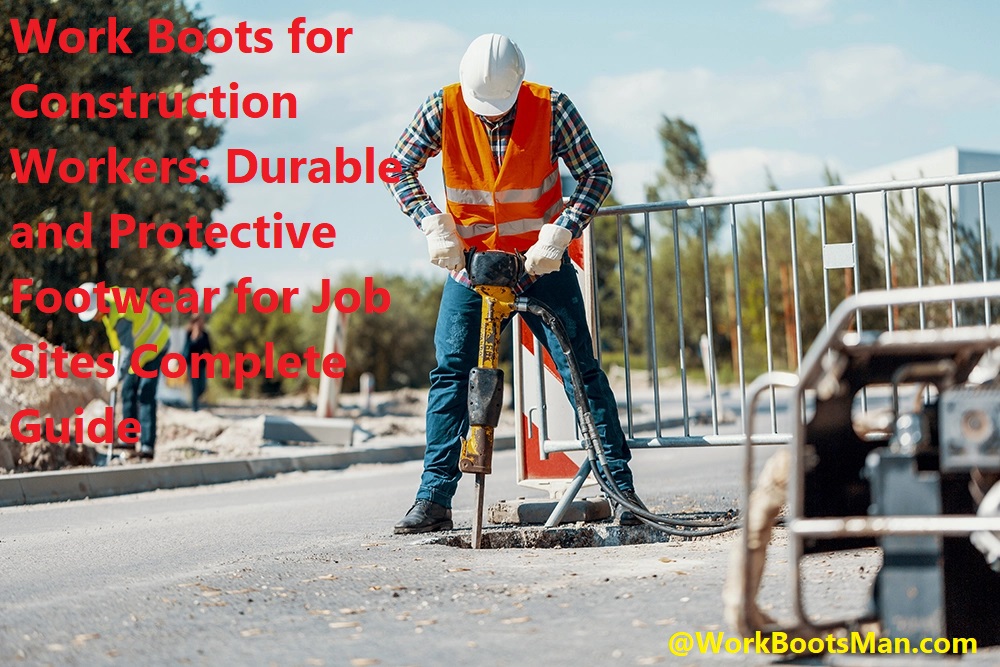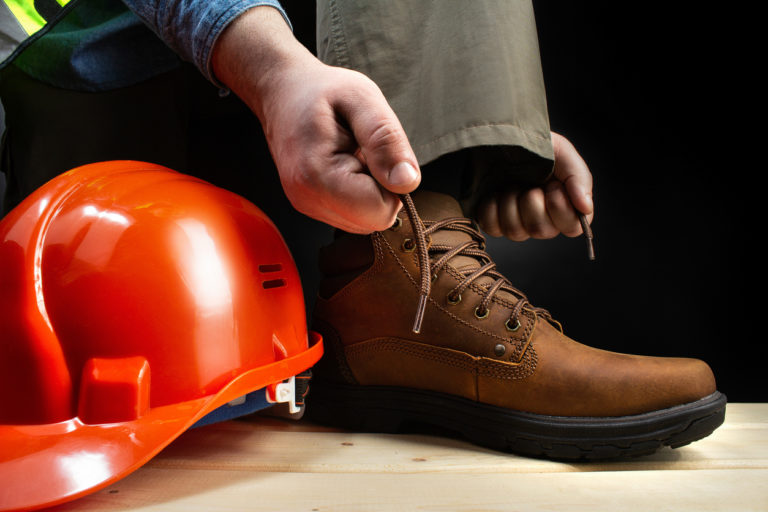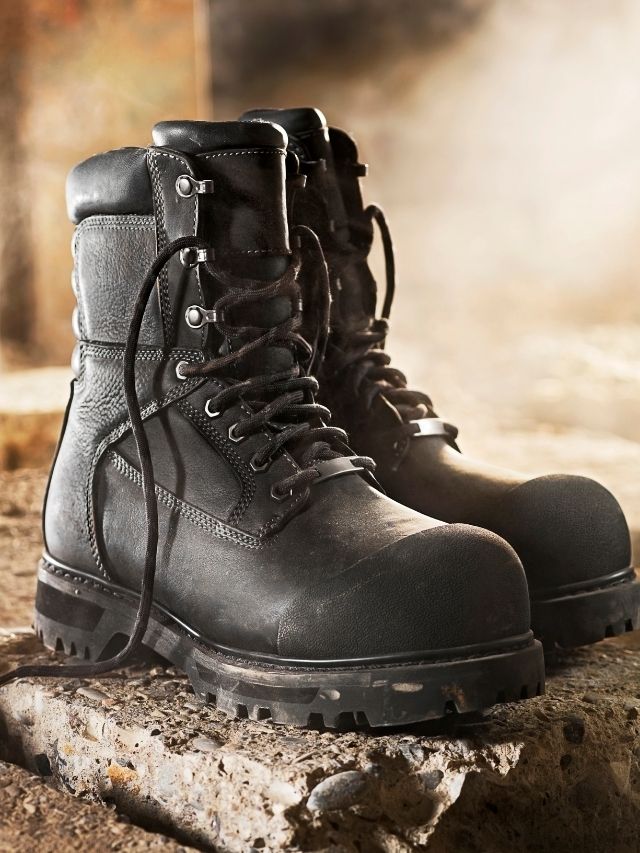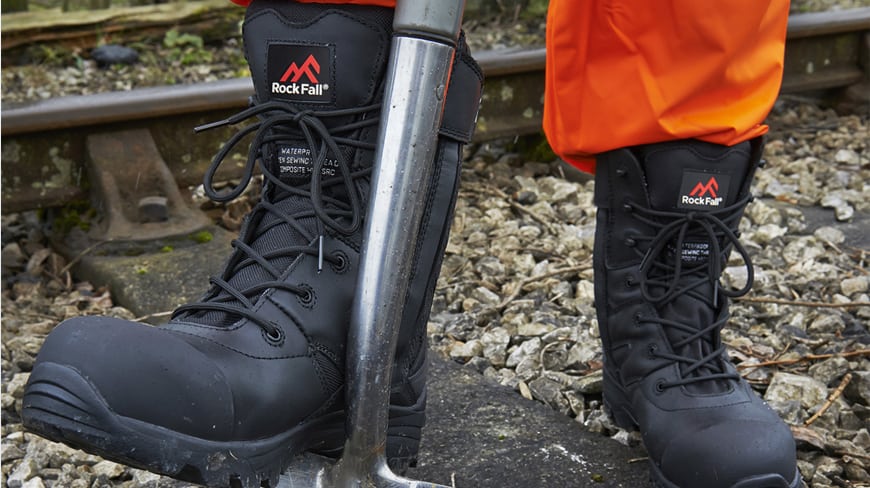Are you a construction worker in search of durable, protective work boots? Look no further- we’ve got the perfect guide for you!
This article covers everything from material and fit to safety features, so you can confidently choose the right work boots for your job site.
When looking for the perfect work boot, there is no single answer that fits all workers and work environments. Construction workers have unique needs when selecting footwear for their job, and it is important to pick the right pair of boots for the task.
Factors like the type of material used, heel height and sole design are all essential when determining which work boot is right for you.
With this complete guide on work boots designed specifically for construction workers, you will be sure to find a pair that provides the optimal protection, safety and durability needed while working on a job site.

Key Features of Work Boots for Construction Workers
It is important to understand the key features to look for when selecting the right pair of work boots for a construction worker. Quality work boots provide superior protection, support and comfort while on the job.
Work boots should have an oil and slip resistant sole that provides traction and grip on a slippery or uneven worksite. Additionally, most often these soles are made of rubber or polyurethane for durability. The same material should be used for the toe cap—which should also meet ASTM standards for compression and impact resistance — or the exterior of your boot could be leather, synthetic fiber or composites like Kevlar.
The heel should be firmly connected to the sole in order to protect from ladder rungs or other hazards on the job site. The ankle area should be at least 6 inches high in order to provide support, prevent sprains during bending, lifting and walking up and down stairs. Furthermore, any mid-soles present need to provide shock absorption while also providing torsional stability (a feature technology integrated into many contemporary shoes) so that it can resist twisting forces during strenuous activities such as running with heavy equipment or kneeling on rough surfaces.
Finally, it is important that your boot is comfortable enough that you do not grow tired during long days of hard labor while still not sacrificing security in any way due to an ill-fitting pair.
Safety toe options (steel toe, composite toe)
Safety toe boots give construction workers the necessary protection for their feet on the job. Steel-toe and composite-toe boots are two popular choices among construction workers, but each option has pros and cons to consider.
Steel-toe boots offer more protection, as they are typically stronger than composite-toe boots and can often handle more impact and compression than composite-toe boots. However, they do tend to be heavier than their composite counterparts. Composite-toe boots provide lighter weight and nonconductive safety toe protection that steel toes don’t have while still providing optimal protection against compression and impact injuries.
No matter which type of safety toe boot you choose, it’s important to ensure that it meets the standards for your industry for foot and ankle protection. Make sure you choose a boot that is compliant with ANSI Z41PT99 standards for protective footwear, so you can be confident on the job site knowing you have durable, protective footwear on your feet.
Slip-resistant soles
When choosing work boots for construction, slip-resistant soles are an important feature. Most manufacturers will provide shoes with sole designs specifically created to minimize slips and falls on wet, oily or slippery surfaces, or those that can handle different terrain in outdoor job sites.
Slip-resistant soles are typically created from highly durable rubber compounds that grip the ground firmly, providing a stable base no matter what surface you are walking on. When shopping for work boots with slip-resistant soles, look for materials such as:
- Polyurethane – A non-marking sole material that is lightweight, durable and offers maximum comfort.
- Durable Rubber – Textured rubber material designed in a non-skid pattern specifically to ensure safety while working on various surfaces.
- Flat wedges – Wedge shaped rubber designed at the heel of the boot to provide extra stability and cushioning on hard surfaces.

Waterproofing and insulation
Footwear designed to meet safety requirements for job sites must also be waterproof and insulated. Workers employed in cold weather climates or who regularly work in wet conditions need boots that are adequately insulated for warmth and waterproofed for dryness.
Besides insulation, waterproofing should also enhance the boot’s breathability to prevent heat build-up, which can cause irritation and fatigue. To improve durability, these boots will typically be made from leather or synthetic materials that are designed to be resistant to prolonged contact with water. Additionally, any stitching used in the boot’s construction should be waterproof, as well as being able to withstand years of flexing while walking.
Many styles of work boots have sealed seams that keep water out at vulnerable points, such as where the upper meets the sole (both midsole and outsole). Some brands may use a specialized fabric lining specifically created with a waterproof membrane that helps keep feet dry while allowing them to breathe during cold working settings.
These attributes are essential when selecting protective footwear for harsh environments such as a construction job site.
Types of Work Boots for Construction Workers
When it comes to work boots for construction workers, there is no one-size-fits-all design. Your feet withstand a lot of wear and tear on the job site, and they deserve the best protection they can get. Different types of work boots offer varying levels of comfort and protection, so it’s important to find the right pair for your job.
For light duty projects, the following designs can provide you with both comfort and safety: -Steel toe work shoes: These are lightweight and flexible enough for everyday wear, but provide your toes with steel protection from heavy objects. -Slip resistant boots: Any type of slip resistant boot can be beneficial in outdoor settings that have spills or slippery surfaces. Make sure to check the tread pattern before purchasing! -Ankle support boots: Your ankles take a lot of pressure on job sites, so look for lace up designs or insulated boots with extra ankle support. They may weigh a bit more than other pairs but are worth it if you’re on your feet all day!
For tougher jobs that require extra support and protection, these heavier duty designs may be what you need: -Safety toe boots: Safety toe designs combine steel toes with a range of supplemental features like additional shock absorption or cushioning. These are best suited if you need extra foot protection while operating machinery or lifting heavy objects. -Waterproof construction boots: Waterproof materials are essential in outdoor environments to keep your feet dry all day long. Look for thick rubber lower halves combined with waterproof uppers to protect against spills and mud splatters. -Insulated winter work boots: Winter weather can make any worksite treacherous without the proper footwear — insulation helps prevent cold air from penetrating into your these workboots have an added bonus — reflective strips add visibility when working after sundown!
Logger boots
Logger boots are popular work boots for construction workers, offering excellent durability, comfort and protection. Designed to withstand the toughest job sites, these heavy-duty boots feature an even higher degree of protection than traditional work boots. The uppers are usually made from thick leather or oiled suede and feature reinforced sections for extra durability.
Logger boots also have higher levels of insulation than regular work boots, with an inner thermal lining to keep feet warm and comfortable. They often come equipped with a heavy rubber or steel toe cap to guard against puncture wounds from sharp objects on the worksite as well as impact resistance.
Besides featuring deeper tread patterns for greater traction on wet and slippery surfaces, some logger style work boots are equipped with additional features such as ladder grip outsoles, water resistant materials and removable mountaineer soles.

Wellington boots
Wellington boots are a popular option among construction workers who need durable, protective footwear. These tall rubber or synthetic boots provide maximum protection and come in brightly colored and reflective patterns. Their height helps to protect the feet, ankles, and lower leg from injury and dirt or debris.
Wellington boots are designed to be easy to pull on and off as well as comfortable for long-term wear in any job site environment. With slip-resistant soles and extra padding around the toes, these boots offer exceptional support for workers who spend most of their day on their feet. Wellington boots also provide waterproof protection from wet or muddy spots on the job site.
Look for models with durable lacing loops that will stay securely fastened all day long, giving you piece of mind that your footwear won’t fail when you need it most. For everyday comfort without sacrificing safety standards, pick up a pair of wellington work boots today!
Materials Used in Work Boots for Construction Workers
Work boots are typically made of durable materials that are able to withstand the hazards of a construction site. The type of material used in the construction of work boots will play a key role in determining the level of protection they offer. Here’s a look at some of the most common materials used in workwear and their properties:
Leather – The majority of work boots are made with leather as it is known for its durability, water resistance, and flexibility. It is available in different grades such as full-grain leather, split-grain leather, suede leather, etc., and provides various levels of protection depending on its thickness.
Synthetic Materials – Synthetic materials such as nylon and PVC combine flexibility with lightweight construction to create a lighter boot that can still offer protection from water and other elements.
Rubber – Rubber is often used for making soles for work boots due to its water resistance, durability, and slip-resistance properties. It also provides additional cushioning from impacts which can be especially useful if you’re working on hard surfaces all day long.
Steel Toe Caps – Steel toe caps are the most common form of reinforced steel that can be found on many types of work boots. They provide superior protection against crushing forces by adding an extra layer between your feet and dangers on the job site.
Leather
Leather is one of the most popular materials for work boots due to its durability and flexibility. Not only is leather waterproof, it also protects against punctures and abrasions, making it an ideal choice for outdoor work sites. Leather can be customized to fit a worker’s foot perfectly and comes in styles ranging from traditional lace-up boots to pull-on ankle boots.
When purchasing leather construction boots, it is important to look for quality as some leathers are treated chemical or have been glued together with cheaper leather pieces. Additionally, full-grain leather provides additional protection against water absorption as well as better overall structural integrity compared to split-grain leather.
Synthetic materials (nylon, PVC, rubber)
Synthetic materials such as nylon, polyvinyl chloride (PVC) and rubber are commonly used in the construction of work boots. Nylon is lightweight with good breathability and low water absorption, making it a great choice for high activity jobs. Its durability makes it a popular choice for mesh panels on insulated boots.
PVC is a strong material that protects from water and wet weather conditions but can become brittle when exposed to extreme cold. It can stand up to abrasion because of its highly dense construction, making it an ideal choice for boot bottoms.
Rubbers are hard wearing and often included in heavy duty work boots to provide stiffness and durability as well as waterproofing benefits. Many work boots also feature a combination of these synthetic materials to maximize comfort, protection and performance.
Gore-Tex and other waterproofing materials
Gore-Tex and other waterproofing materials are a great option for construction workers who want to keep their feet dry in wet conditions. Breathable and waterproof, these boots feature a special membrane liner that limits moisture penetration, while still allowing sweat and excess heat to escape. This helps promote comfort during long days on the job site.
Gore-Tex is also known for its durability and ease of maintenance. Some brands even offer construction boots with removable liners, allowing you to wash them separately or replace them if they become worn with age. Leather uppers are often also added to waterproof construction boots for additional protection from the elements and from abrasion when working outdoors.
Finally, Gore-Tex is often highly breathable due to its advanced design – more so than traditional rubber or plastic skin as found on typical work boots for construction workers. By maintaining a consistent temperature inside the boot, it helps maintain comfort throughout the day and eliminates the build up of sweat which can lead to blisters and other foot irritations.

Conclusion
You have now gone through a complete guide to finding the most suitable work boot for your needs as a construction worker. It is essential that you keep safety, comfort and performance in mind when selecting the proper footwear for any job site. In addition, budget should also be taken into account for purchasing durable and protective boots.
When it comes to choosing work boots for construction workers, there is an ever-increasing number of companies offering different styles and features. Make sure you pick one suitable to your individual needs and that offers excellent protection on job sites. The right pair of boots can not only keep you safe but also increase your productivity while giving you unparalleled comfort and support throughout your long day at work.
FAQ’s
Which shoes are best for construction site?
The shoes that are best for construction sites are work boots that are specifically designed for the job.
What are the best work boots for construction workers?
The best work boots for construction workers are those that are made of durable materials, have slip-resistant soles, and offer good support and protection.
What shoes to wear on a job site?
It is recommended to wear work boots that provide protection and support on a job site.
What type of shoes should be worn on industrial or construction work sites?
The type of shoes that should be worn on industrial or construction work sites are work boots that meet the safety requirements of the job and provide adequate protection and support.
Which shoe material is more durable?
Materials such as leather, synthetic fabrics, and rubber are known for their durability and are often used in the construction of work boots.
How to choose construction boots?
When choosing construction boots, it is important to consider factors such as the job requirements, the level of protection needed, and the comfort and fit of the boots.
What is safety boots in construction?
Safety boots in construction are work boots that are designed to provide protection and support for workers on construction sites.
What do construction workers wear on site?
Construction workers typically wear work boots, hard hats, and other protective gear such as gloves and safety glasses on site.
What are the shoe requirements for construction sites?
The shoe requirements for construction sites may vary depending on the job, but generally, work boots with slip-resistant soles and toe protection are required.
Why wear safety boots on a construction site?
Wearing safety boots on a construction site can help to prevent injuries such as slips, falls, and toe injuries, and provide support and protection for the feet and ankles.
See Also :
- Best work boots for painters 2023
- Best lightweight waterproof work boots 2023
- Best work boots for construction workers 2023
- Best work boots for diabetics 2023
- Best work boots for electricians 2023

